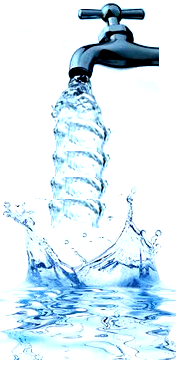Purified Water
We will discuss here how we get purified water.
We know the rain water which is absorbed by the soil, goes under ground. This water gets purified as it goes down through different layers of the soil. We get this purified water as well water, hand pump water and tube well water. The water from these sources is safe for drinking. However water from rivers, pond, lakes, etc. needs to be purified for drinking purposes and domestic uses.
The following ways will help us to get purified water:
(i) We have noticed that sometimes water contains germs and diseases. Boiling kills the germs from the water. So boiled water after it gets cooled, it is considered safe for drinking purposes. Often ill persons are advised by the doctor to drink boiled and cooled water.
(ii) Water sometimes contains suspended impurities. Such
water should be filtered. Filtration can done by passing the water through
layers of gravel and sand, packed in a earthen pot.
(iii) However only boiling or filtering does not remove all the impurities. So, we must boil the water first, then after cooling, it should be filtered then, the germs and suspended impurities both are removed. Such water becomes clean and safe for domestic uses.
(iv) In towns and cities purified water is supplied to citizens. Water is collected from rivers or canal or through tube-wells and is collated in big tanks. A small quantity chlorine or bleaching powder is added to the water to kill the germs. This chlorine added water is sprayed into air to remove the odour. Finally it becomes safe for drinking. This purified water is supplied all over the city through pipelines.
From Water in Our Life to HOME PAGE
Recent Articles
-
What Is Plasma? | Blood Plasma | Proteins | Nutrients | Cholesterol
Nov 07, 25 10:29 AM
Blood is a mobile fluid which is a connective tissue and is derived from the mesoderm like cell any other connective tissue. Colour of blood is reddish and that flows inside the blood vessels by means… -
Disorders of Respiratory System | Tuberculosis | Pleurisy | Emphysema
Oct 28, 25 11:39 PM
Tuberculosis is very common disease and is caused by a type of bacteria called Mycobacterium tuberculosis. This disease causes different trouble in the respiration and infection of several parts of th… -
Regulation of Respiration | Respiratory Centres | Inspiratory Area |
Oct 14, 25 12:13 AM
Respiratory Centre is the area that controls the rate of respiration and it is observed to be located in medulla oblongata and pons. Respiratory Centre has the following will dispersed components like… -
Explain Transport of Gases | External Respiration | Tissue Respiration
Oct 09, 25 11:35 PM
In humans gaseous exchange is completed in the following ways the steps are - External Respiration or Breathing - Breathing in false taking in of Oxygen and giving out of carbon dioxide in the body. M… -
Kind and Number of Teeth | Location of Teeth in Mouth | Care of Teeth
Sep 11, 25 12:52 AM
Kind and Number of Teeth






New! Comments
Have your say about what you just read! Leave me a comment in the box below.